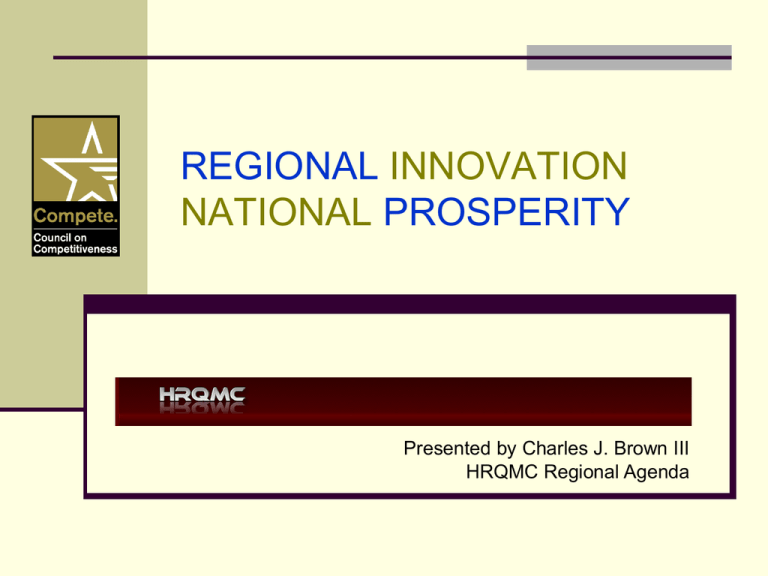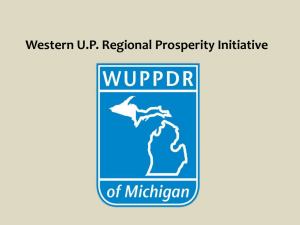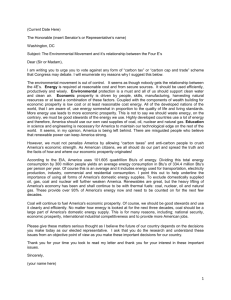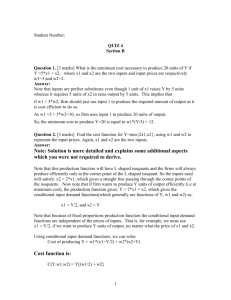Regional Innovation, National Prosperity
advertisement

REGIONAL INNOVATION NATIONAL PROSPERITY Presented by Charles J. Brown III HRQMC Regional Agenda The Challenge Large industrial operations or headquarters Tax incentives Inexpensive labor Production shifted elsewhere Intellectual Capital (Knowledge) Quality of employees Reputation of a brand Skills and knowledge about how to make goods or services Success critical individuals or groups Aggregation of information of value that is not common knowledge The Challenge Economic development strategies Incentive-based strategies The Answer: Innovation The nature of Innovation is changing Faster Multidisciplinary Collaborative Democratized Global The Risk 50% of all U.S. patents are foreign Japan, Korea, and Taiwan are 25% of that Sweden, Finland, Israel, Japan, and S Korea each invest more in R&D to GDP than U.S. 2004 China became world leader of exporting ICT e.g., Mobile phones, laptops, digital cameras 6 of the 25 leading IT companies are in the U.S. 14 are based in Asia The Conclusion “The capacity for innovation is going global — and we must pick up the pace … today, the forces of global economic integration and advances in technology are creating a different and more complex challenge. Sustaining competitive advantage will require moving beyond efficiency and quality toward creating new markets, increasing choice and value to customers, and innovating continuously on a global basis.” The Paradox: The Region Proximity Contact Suppliers Customers Industry Academia Industry clusters Diversification and Differentiation Diverse people, land, services, etc. Specialized infrastructure educational institutions, and workforces The Five Common Challenges Promoting regionalism Building and retaining talent Transitioning to advanced manufacturing Networking knowledge assets Energizing the entrepreneurial economy Innovation-based Regional Economic Development Model Prosperity Productivity Innovation Measuring Regional Innovation Key objectives for the Regional Innovation Initiative Improving awareness among federal, state, and local stakeholders of the conditions necessary to promote innovation-based economic development Catalyzing consensus on policy priorities and practices to strengthen the regional platforms for innovation Measuring Regional Innovation Key objectives for the Regional Innovation Initiative Supporting a forum for business, academia, government, and supporting organizations to build partnerships by sharing new ideas and best practices; Providing tools and techniques that allow states and regions to inventory, evaluate and benchmark their innovation capacity Accelerating implementation of local economic development initiatives Measuring Regional Innovation Review of Previous Data Comparative Data Analysis Regional Business Survey Community Leadership Interviews Inputs to Innovation Capacity Assets Human Capital Research and Development Institutions Financial Capital Industrial Base Physical Infrastructure Legal and Regulatory Environment Quality of Life Inputs to Innovation Capacity Networks Collaborative economic development partnerships Angel capital networks Research partnering Universities Businesses Workforce development programs Informal networks City sports leagues University alumni associations Inputs to Innovation Capacity Culture Collaborating and sharing with competitors Attitude toward risk Appreciation of diverse experiences and background Regional Innovation Environment Inputs Regional Innovation Environment Assets Networks Culture Outputs Innovation Productivity Prosperity Websites www.HRQMC.org www.compete.org www.compete.org/publications/idea/7/regional-innovation Regional Innovation National Prosperity Measuring Regional Innovation











